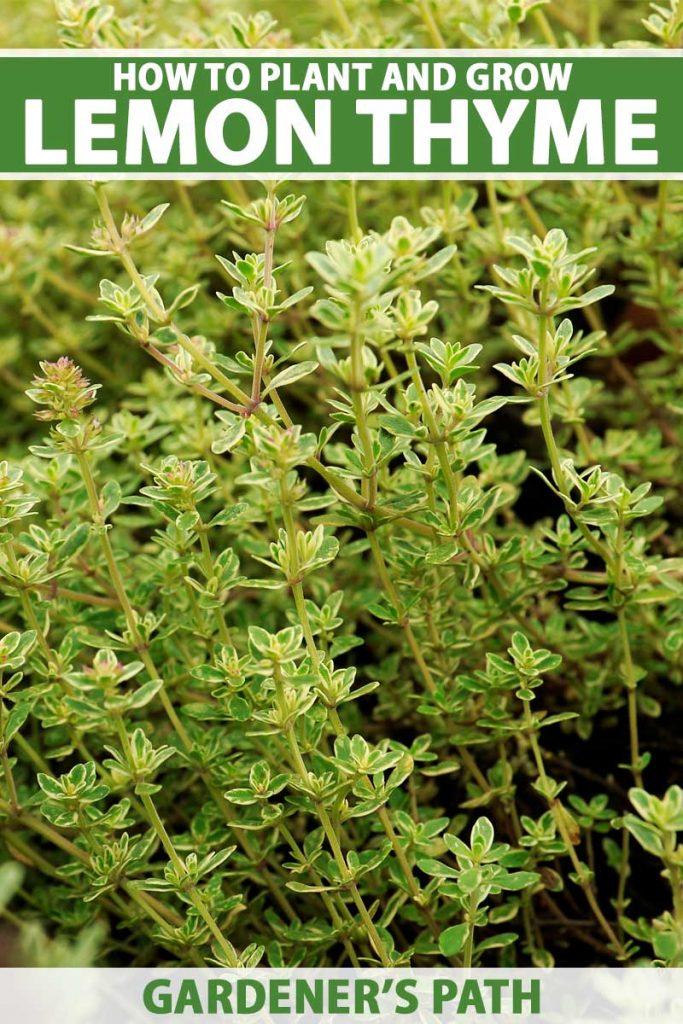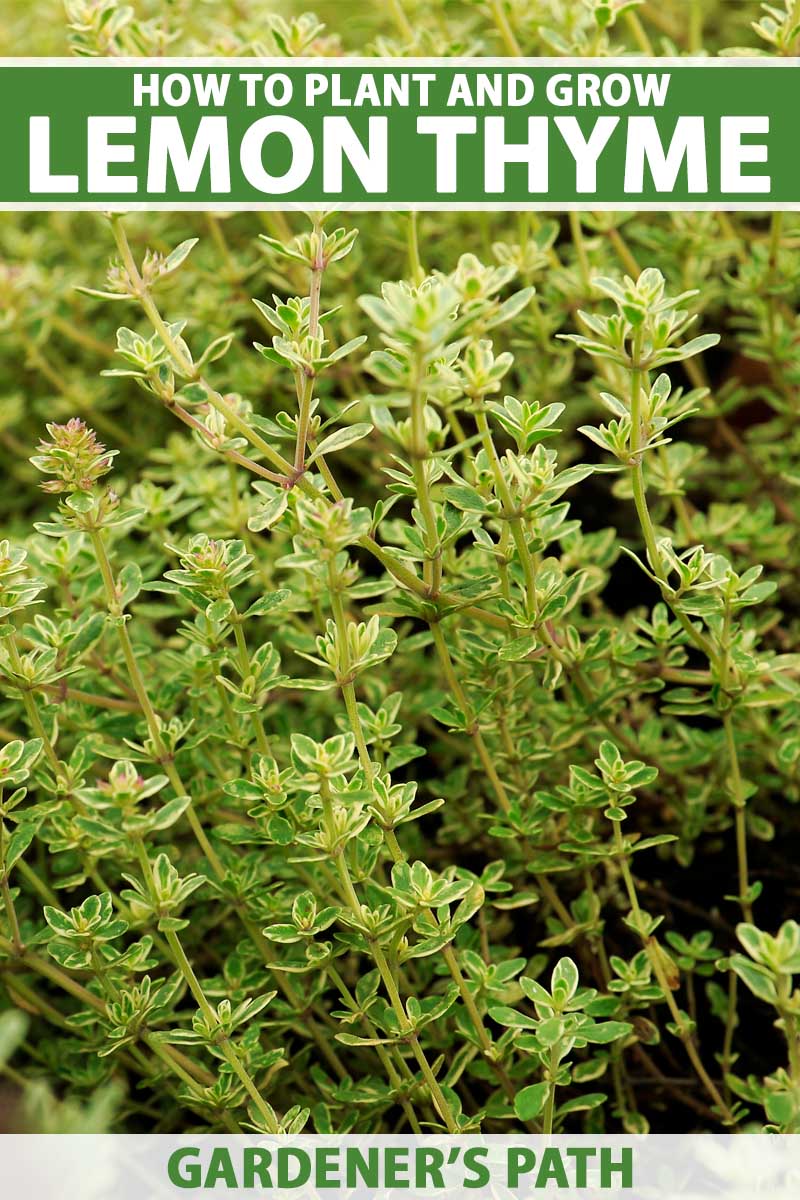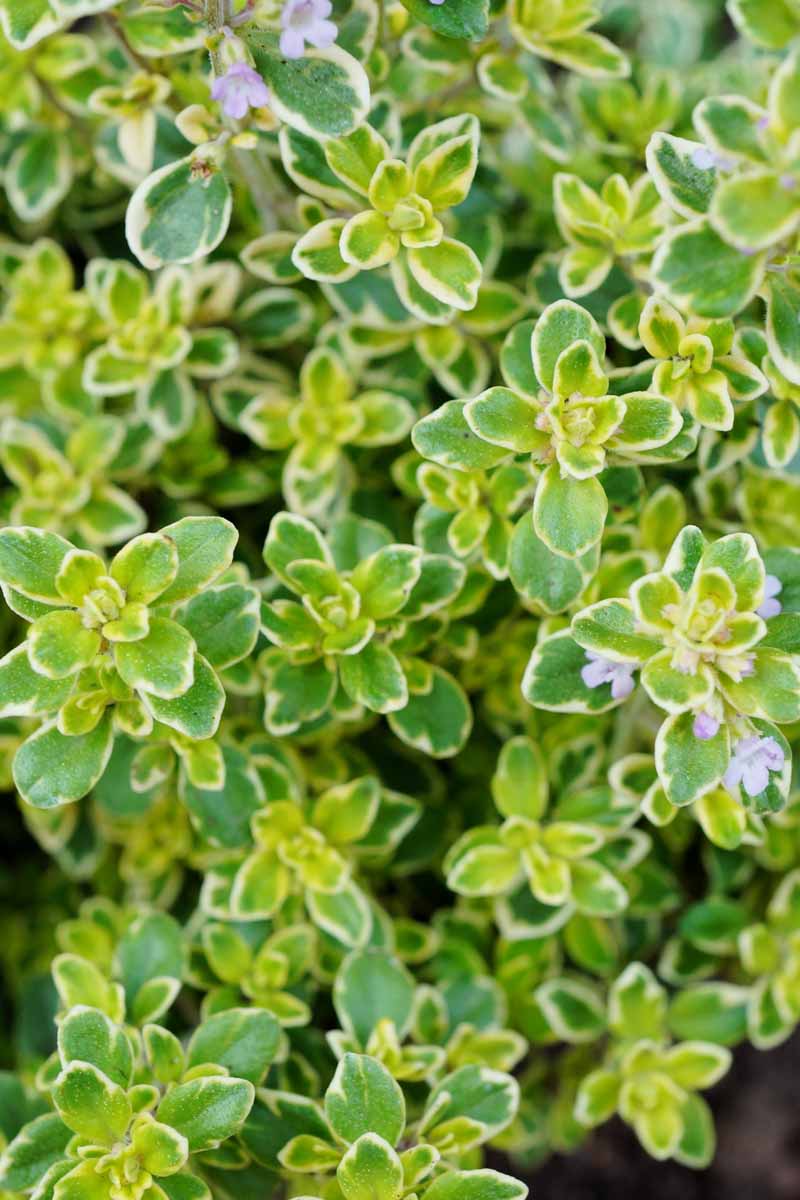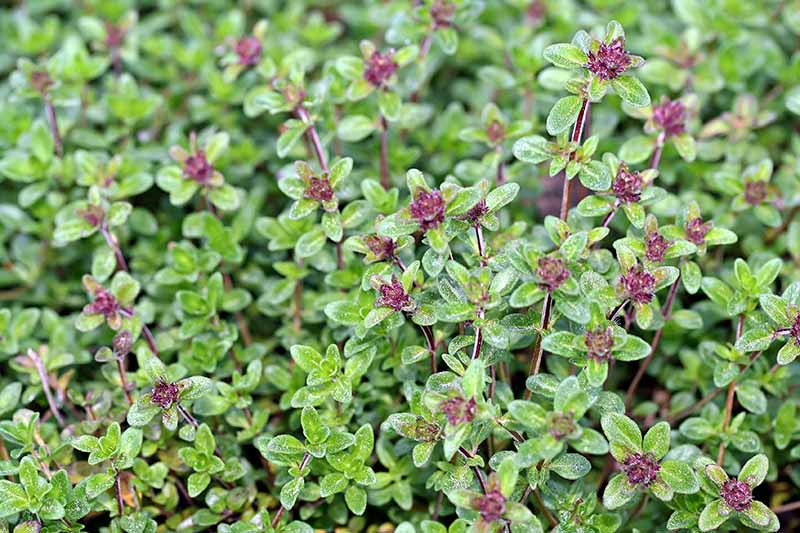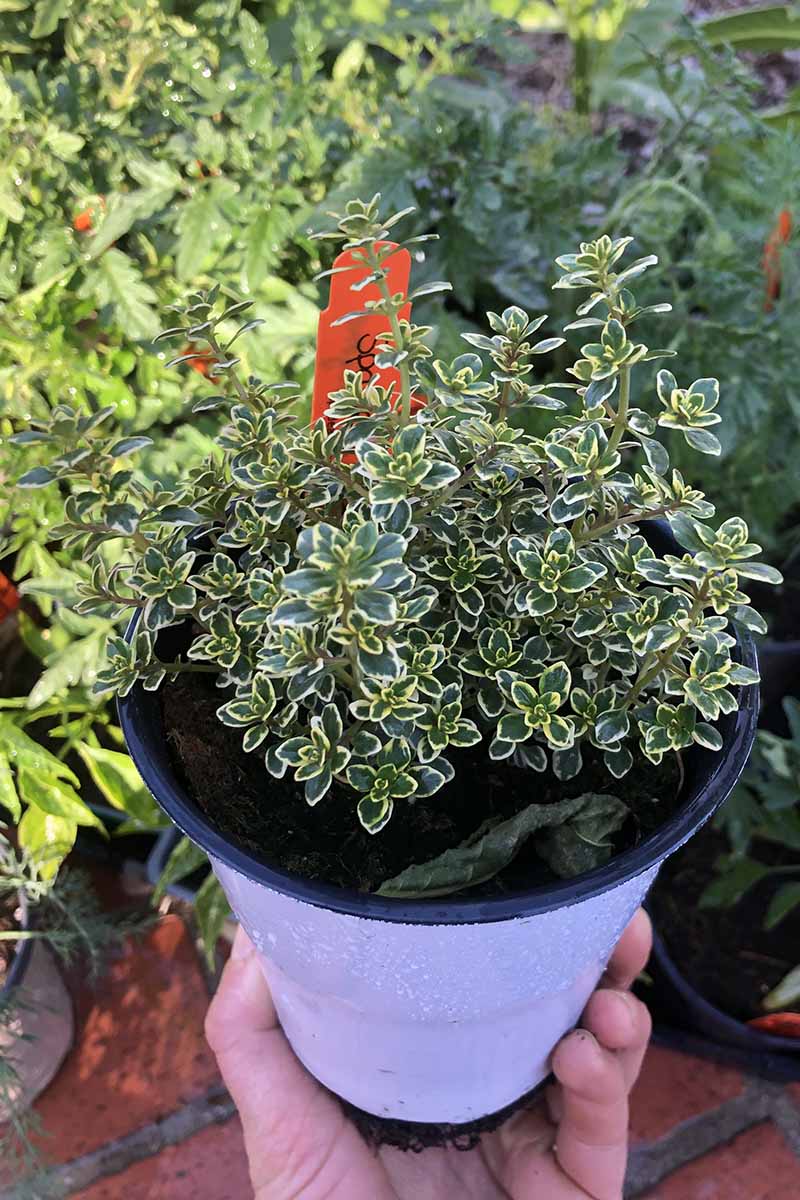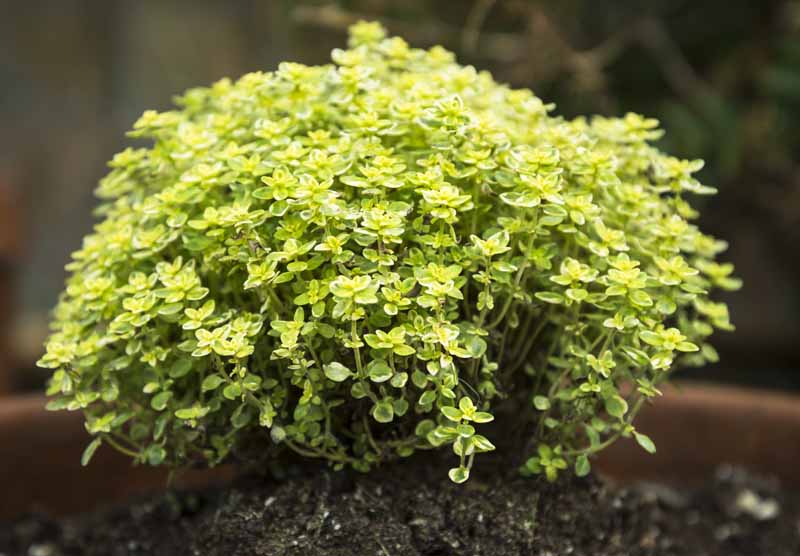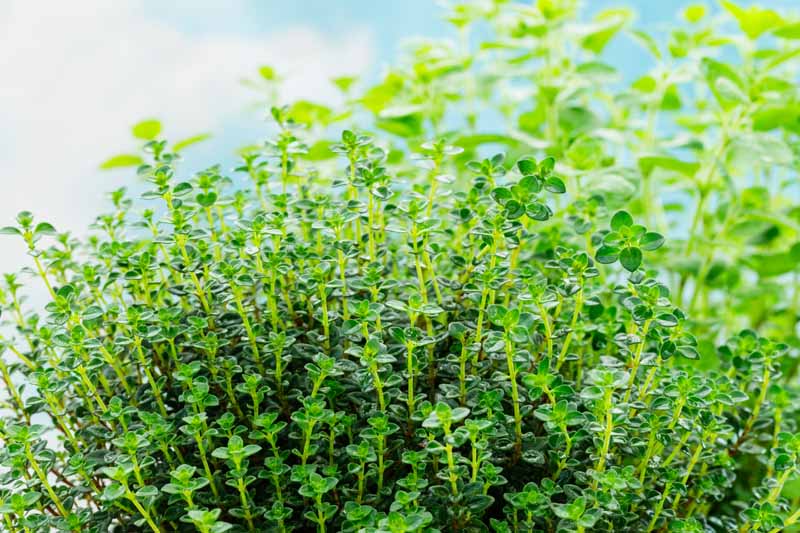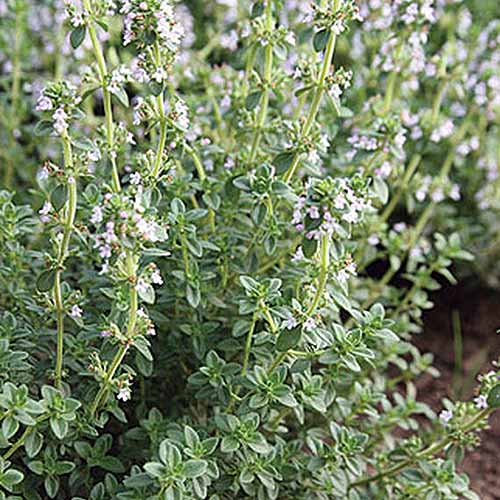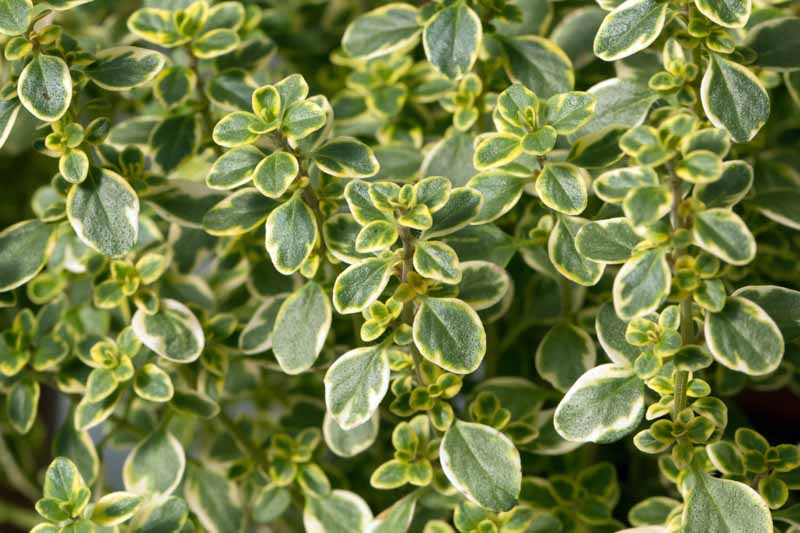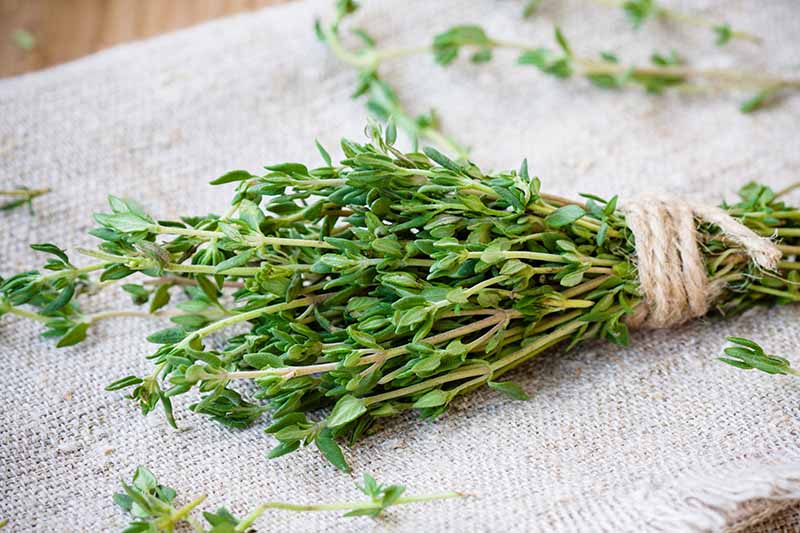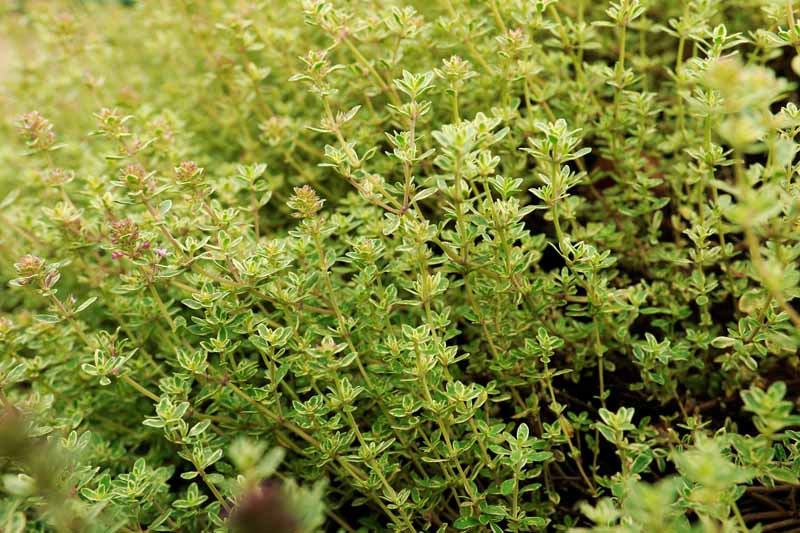As one of the most flavorful culinary thymes, this lemony-earthy herb accentuates the natural flavors in fish and poultry, and makes for a beautiful addition to your herb garden. Not only does this plant offer gastronomical intrigue, it also appeals to beneficial insects and pollinators. Whorls of lavender-pink flowers throughout the summer encourage an influx of ladybugs, hoverflies, and parasitic wasps, making this herb an excellent companion plant for your veggie garden. We link to vendors to help you find relevant products. If you buy from one of our links, we may earn a commission. Growing to about six to 12 inches tall by 12 to 18 inches wide, the compact, aromatic nature of lemon thyme enables it to serve as a nice border plant along your garden beds or edging a path. It can tolerate some light foot traffic and will release gentle wafts of citrus into the air if stepped upon. Fun fact: this fragrance actually acts as a defense mechanism to deter herbivores from gnawing away at the leaves. Nevertheless, humans are undeterred and actively seek out such fragrant plants for our enjoyment and to fulfill our culinary desires. Hmm… are we the ones cultivating lemon thyme, or is this aromatic plant perhaps cultivating us? Thanks to a small root system, it may also become established easily in a rock garden or retaining wall. Wow, what a plant! Keep reading to learn how to sow and grow this herbal queen in your own garden.
Cultivation and History
T. citriodorus is a perennial herb easily grown outdoors in USDA Hardiness Zones 5-9. For many years, lemon thyme was thought to be some kind of hybrid plant in the Thymus genus, but recent DNA studies have proven that indeed, our dear friend T. citriodorus is its own plant species. Both chefs and herbal medicine makers are drawn to the sharp scents of citrus tinged with the earthy herbal essence of thyme. The leaves can be incorporated into various soups, salads, and sautees, both as a fresh or dried flavoring herb, and accentuate the natural flavor profiles of fish and meat dishes in particular. With a sharp, lemony fragrance, the plant is often included in perfumes, skincare products, and cosmetics, and can also be utilized in homemade insect repellent and essential oil aromatherapy.
Propagation
Plant T. citriodorus in the spring. Though plants are most easily acquired from your local nursery as young starts, you can also choose to propagate from seed, or from a friend’s plant through root divisions.
From Seed
Thyme seeds can be slow to germinate and gardeners typically choose to propagate from cuttings or divisions instead. However, if you so choose to sow, here’s what to do. Sow seeds indoors in early spring or directly outdoors after all danger of frost has passed. In either case, broadcast the seeds on top of the soil, gently pressing each seed no further than 1/16 of an inch into the earth. The trickiest thing with sowing seeds is to ensure that the soil stays consistently moist, but not waterlogged. Gently water the pots or sowed area on a daily basis to ensure success. Transplant as described below.
From Cuttings
You can take stem cuttings from established plants in early spring, when new growth is evident. Cut a three- to four-inch length of stem, and remove the leaves from the lower half. Prepare a small container filled with a well-draining potting medium. You can use powdered rooting hormone, if you have some to hand, though it’s not strictly necessary. Make a hole in the potting medium with a pencil or your finger, and place the cutting one and a half to two inches deep. Water deeply. Keep the cutting in a sheltered location, out of direct sunlight, and maintain even moisture in the potting medium. You may cover it with a humidity dome or a plastic bag to maintain a moist environment. It should start to root after four to six weeks, evidenced by new leaf growth. Transplant out into the garden as described below.
From Divisions
After your thyme plant has become established and matured for a few years, it is ready to be propagated by root division. Divide either in the spring or in the fall. First, dig up the whole root ball of the plant. Gently shake out the excess soil to expose the roots. Then break the plant into three or four sections, teasing out the tangles in the roots as gently as possible. Once the plant is divided, replant one section into its original home and transplant the other sections into new parts of the garden, or grow them first in pots to allow roots to reestablish. Water two to three times a week in order to help the plant readjust.
From Seedlings/Transplanting
Plant T. citriodorus either as seedlings, division transplants, or starts from the nursery. Dig a hole the same depth but twice as wide as the container, place the seedling in the hole, and gently backfill the soil. Be sure to give the plants a good, deep watering and lots of love to welcome them into the space. What qualifies as love for this tasty herb? More on that in the next section!
How to Grow
Locate a site in your garden that receives full sun, more than five hours of sunlight per day. Make sure the soil drains well – thyme plants enjoy a variety of poor, rocky, nutrient deficient soils, so long as their roots don’t get waterlogged. After planting, water deeply two or three times per week, or when the soil is dry an inch or two deep, to help establish their roots. After a few weeks of this you can begin to ease up on watering until you’re watering once a week, then once every other week, then just once in a while. Alternatively, you can grow T. citriodorus in a container. Select a pot six to 12 inches inches in diameter. Make sure to check the container has adequate drainage holes. Keep in mind that T. citriodorus has relatively compact roots and the pot does not need to be as deep as it is wide. Plant in well draining potting soil and amend with sand, vermiculite, or perlite if necessary. Container plantings typically require more regular watering than plants in the ground, usually two to three times per week even after they’re mature. Before watering, double check that the soil is dry to an inch or so deep to avoid root rot caused by oversaturation. No need to fertilize these little buddies! Once established, they will hold their own.
Growing Tips
Plant in well-draining soil. Provide a full sun location.Allow soil to dry out to an inch or two deep between waterings.
Pruning and Maintenance
Once established, T. citriodorus is a pretty low maintenance herb. After the plant finishes blooming, you can deadhead to encourage new growth and/or shape the plant as you like. Otherwise, you can elect to take a more hands-off approach and let the plant grow as it pleases. In Zones 4-6, apply a two to three inch layer of mulch at the beginning of winter to protect the plant’s roots from cold soil temperatures. T. citriodorus is a robust herb that may lose some leaves but will typically survive harsh winters. After a few years, you’ll start to notice the stems at the base of the plant getting progressively woodier. At this time, you can choose to divide and replant sections, or you can prune the plant to encourage new growth closer to the base.
Cultivars to Select
For example, ‘Aureus’ has a mounding form while ‘Golden Dwarf’ hugs the ground. T. citriodorus You can find T. citriodorus in quart-sized containers available at Burpee. Slight variations in foliage, growth habits, and aroma distinguish T. citriodorus cultivars from one another. ‘Archer’s Gold’ and ‘Golden Lemon’ provide lavender-hued flowers while ‘Golden Queen’ offers pink blooms. ‘Lime’ provides a similar citrus flavor with more hints of lime rather than lemon. While the essence of the plant remains consistent across cultivar boundaries, these subtle differences create distinctions between varieties.
Managing Pests and Disease
There’s no need to be too concerned with pests or disease when you are growing lemon thyme. There may be minor issues with aphids or spider mites, as with so many other plants in the garden, and only if planted in poor-draining soil or if overwatered will you encounter fungal diseases.
Insects
In my garden, thyme is one of the most resilient of plant friends. Although other gardeners have reported aphids or spider mites as being a potential threat, never have I ever seen pests bothering these dudes.
Aphids
A classic garden nuisance, aphids will quite literally suck the life juice out of plants, often spreading disease through their saliva. These tiny light green bugs are found on the undersides or tips of leaves. Key giveaways include leaf curling, color disfiguration, and brittleness. If dealing with a case of the aphids, start by giving the plant a hard spray down with the hose, focusing on the areas directly affected. This mechanically pushes the aphids off the plant. I choose to use the “flat” setting on my hose nozzle for this task. If you’re dealing with a more significant infestation and looking for a more intense level of treatment, first spray down the plants with water, then follow with a heavy spritz of alcoholic soapy water. To make your own, combine one cup of rubbing alcohol, one quart of water, and one to two teaspoons of dish soap in a spray bottle. A hard spritz of this mixture kills the aphids while leaving the plant unharmed – just be sure to wash off the soapy water a few moments after application to avoid burning the leaves. Monitor aphid activity closely, and repeat weekly until they are gone. Read more about battling aphids in your garden here.
Spider Mites
Similarly to aphids, spider mites will feast off the plant’s vitality, rendering it weak and brittle. And again, they do not typically pose a serious threat to T. citriodorus. These small spider-like mites can be difficult to spot, but you’ll notice the presence of their fine webs, which cover the leaves and stems of plants. Spider mite infestations can be treated in the same way as aphids, with hard spray downs and soapy water treatments.
Disease
Perhaps more likely to threaten your lemon thyme plant is some type of fungal disease, the most common being botrytis rot (caused by Botrytis cinerea), root rot (via Rhizoctonia solani), and Alternaria blight (from Alternaria brassicola). Fungal activity typically occurs under warm, humid conditions. Be sure to plant your T. citriodorus in well draining soil, and allow soil to dry out before watering again to avoid oversaturation. If affected by rot or blight, first mechanically remove all infected areas on the plant. Disinfect any equipment before and after pruning to avoid spreading disease from plant to plant. You can also increase airflow by pruning or staking the plant into an upright position. And mulching underneath the plants will prevent fungal spores in the soil from splashing onto the leaves.
Harvesting
One of the great joys of growing your own food and medicine is being able to harvest and utilize the gifts of the plants you’ve tended. Though any time of the day is fine, harvesting in the morning just after the dew has dried is best, to minimize wilting. That being said, I typically find I’m the most inspired while I’m in the middle of cooking and tend to run out to gather a few sprigs just after the sun has gone down. Similarly, while you can harvest throughout the year as needed, the flavor of the leaves is supposedly most potent just before flowers open. Harvest by snipping a few inches down the stem of the plant, just above a node of new growth.
Preserving
To maximize your harvest and extend the shelf life of fresh leaves, you can elect to wrap clusters of thyme sprigs in a damp paper towel and store them in a zip-top bag in the fridge. This allows you to conveniently cook with fresh thyme at any time. You can also dry and jar T. citriodorus to keep a steady supply on hand. A few techniques include hang drying, oven drying, and dehydrating in a specialized machine. Give these a try:
Hang Drying
The simplest method, it involves bundling fresh sprigs of thyme with twine or a rubber band. Hang the bunches from a nail on the wall or a hook in a warm, dark place and allow leaves to completely dry, for about one to two weeks. Some people choose to hang the herbs in a paper bag to prevent dust from settling. When fully dry, run your fingers down the stem of each sprig to remove the leaves. Store them in a mason jar or other airtight container for regular use.
Oven Drying
A bit quicker, this can be done within a few hours. On a baking sheet, layer sprigs in between parchment paper and bake at 100°F for two to four hours. Once leaves are dry and crumble easily, remove from the oven and allow to cool on the pan. After the sprigs have fully cooled to room temperature, remove the leaves from the stems by hand and store in an airtight container.
Dehydrating
The quickest drying method calls for a food dehydrator. You can read about some of the top recommended models on our sister site, Foodal. Place sprigs on the dehydrator tray and set the temperature to 100°F. Dehydrate for one to two hours until the leaves are completely dry. Strip and store. Dried thyme can be stored in an airtight jar in a cool, dry place like your spice cabinet. Read our full guide to drying herbs or find more info on preserving fresh herbs on our sister site, Foodal.
Cooking Tips
An excellent companion in the kitchen, the leaves add layers of flavor to a variety of dishes, including sauces, salads, soups, seafood, and poultry. The subtle zest of lemon mixed with the herbal taste of thyme brings out the natural flavors in fish and meat, but cooked too long, the herb loses its seasoning essence. Fresh thyme is a great addition to vegetable and seafood sautees and can also be used in a seasoning rub. I often incorporate a few sprigs when making hummus or an herb-y sauce. Leaves can be used fresh or dried, in any recipe where you would typically incorporate the standard variety. If you are slow cooking a stew or making something else that will be on the stove for a while, wait until just before serving to add a few pinches of crushed fresh or dried leaves. Running my hands through their soft foliage can be such a joyful and childlike experience. Gently rubbing my fingers across the delicate small leaves and releasing their aroma triggers feelings of calm and creativity. Now, I welcome you to get to know T. citriodorus through planting and growing it in your own garden, whether herbal or fragrant (or both!). Please share any questions or experiences you have with lemon thyme in the comments section below, and happy gardening! For more information on growing herbs in your garden, you’ll need these guides next:
How to Grow and Care for Common ThymeHow to Grow Creeping Thyme as an Aromatic Ground CoverHow to Start Your Own Herb Garden
